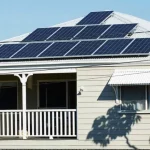With the rapid increase in demand, the solar panel manufacturing industry is turning its heads to the technological side of the page. Companies are showcasing their innovative ideas with consumers around the world, thus building up a healthy competition. Bifacial solar panels are although a recent induction in the solar market but they cannot be ruled out either as they clearly stand apart from the regular solar panel.
The name itself is self-explanatory but for those still curious, bifacial solar panels are pretty much the regular solar panel except that they can store sunlight from both sides of the panel. Bifacial solar panels are capable of producing solar energy by utilizing both sides of the solar plate. In bifacial solar panels, the rear side of the panels is kept transparent by using tampered glass instead of a reflective coating. This way the solar panel not only utilizes the direct sunlight but also the light reflected from the surface. Hence it increases the production capacity of the installation.
Bifacial Solar Panels Advantages.
Below are a few advantages of bifacial solar panels.
Maximum efficiency:
The bifacial solar panels tend to be more efficient than the mono facial panel. Because of their capacity of utilizing both sides of the panel they are remarkably capable of producing more solar power, that too with extreme efficiency.
Small installation space:
If your power needs require a good number of solar panels but the installation site does not have that much space, you can still meet your energy requirements by installing bifacial solar panels. Their two-way build can help you meet your energy goals and that too without worrying about having not enough space.
Durability:
The tampered glass is a crucial ingredient in the manufacturing of bifacial solar panels. They not only increase the light-absorbing capacity (at the rear end of the panel) but also give a sounding edge in terms of overall durability. The bifacial solar panels are observed to be more resilient towards strong winds and other factors that may compromise the efficiency of the panel.
Backup energy production in Bad Weather:
The bad weather can directly affect your production capacity if you’re using mono-facial panels. Whereas things are different if you’re using bifacial panels as they continue to work. Even though the front side of the panels is affected by the bad weather, the rear side continues to work efficiently unaffected by the troublesome weather.
The angle of installation:
With a bifacial solar panel, there is no to worry about any particular angel for installation. They can be installed at any angle and it will not affect their efficiency. Unlike mono-facial panels they can be installed even at 90 degrees of angle and still the efficiency won’t drop.
Bifacial Solar Panel Disadvantages.
With all the good things about bifacial, there are certain drawbacks to them as well. These disadvantages are discussed below.
Overweight:
The bifacial solar panels have a fair share of weight on their side. Which makes them extremely heavy and requires a great deal of care in handling. Their heavyweight can also compromise the strength of the roof if the installation is roof-mounted. Their heavyweight means their mobility is limited and their maintenance is a bit difficult too. It is good for the consumer to hire a professional solar engineer to assess the structural integrity of the roof before installation. Also for installation, the customer must hire experts who profess in handling such overweight beasts of the solar industry.
Overpriced:
The bifacial solar panels are not only overweight but also slightly expensive than the mono-facial panels. Their installation cost edges to that of regular installation. But that also means they are equally cost-effective. Their expensive cost is overshadowed by the increased energy production. Keeping that in view they equal the overall cost of the energy compared to mono facial.
Reflective Surface:
To fully utilize the bifacial solar panels it’s best to have a surface that reflects the sunlight. That can be done by painting the mounting surface with reflective paint. This significantly increases the installation cost thus making an already costly installation a bit more expensive.
Conclusion:
Bifacial solar panels have their pros and cons but their impact on the solar market is definitely huge. Therefore, if you have decided to install a bifacial solar panel, we highly recommend you to consider all the things we discussed and make the right choice.





1 Comment
Mohd alabbas
We ask about suitable height that bifacial panels need